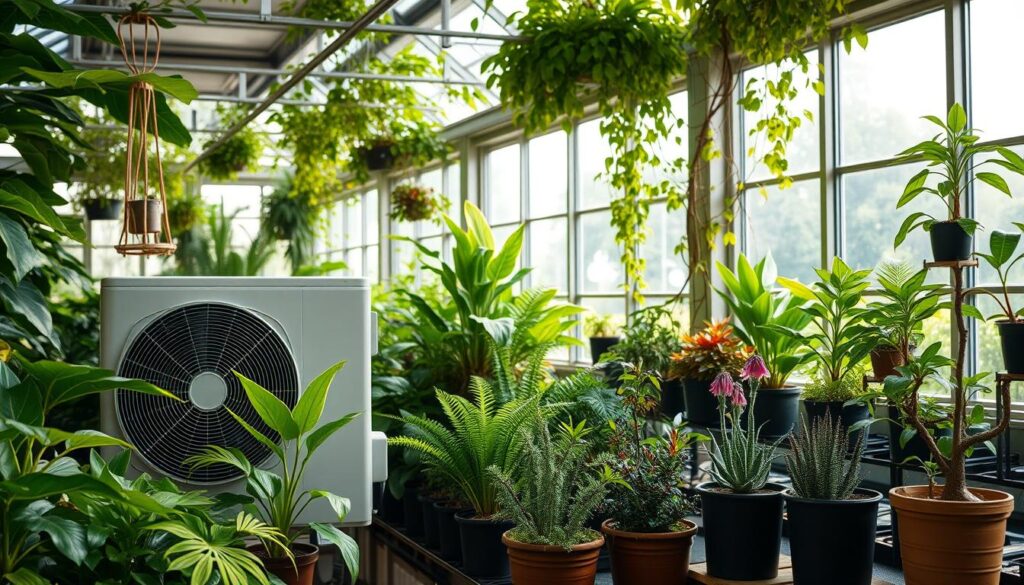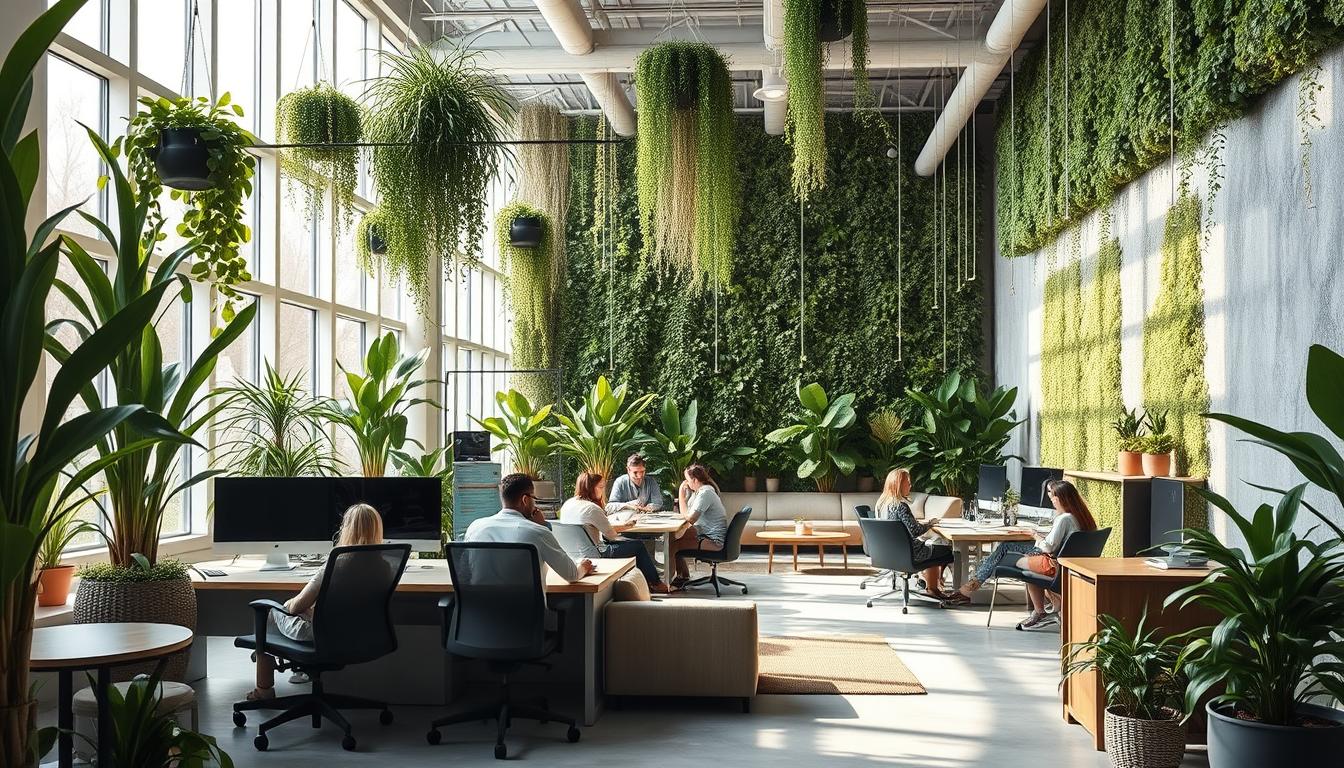We live in a world that aims for sustainability more each day. That’s why the push for green HVAC systems is growing. These systems use less energy and cut down on greenhouse gases. They also bring in new tech that works with plants to make our homes and workplaces eco-friendlier. Let’s take a closer look at the perks of green HVAC. We’ll also see the latest advancements and how they make our living spaces better.
Introduction to Green HVAC Solutions
Green HVAC stands for a move towards saving energy and caring for the planet with our heating and cooling systems. Traditional systems put a lot of greenhouse gases into the air, harming both the environment and our health. By choosing green HVAC, we can lessen that harm and make the air inside more comfy.
These green tech options use the earth’s natural gifts and smart designs to meet our need for cool summers and warm winters. They bring in renewable energy and make systems run better, cutting down on how much energy they use and what they cost to run. More and more homes and businesses see the good in green HVAC, making a path for a healthier planet.
Knowing more about green heating and cooling tech can lead to big wins in saving energy and protecting nature.

The Importance of Sustainable Heating and Cooling
Sustainable heating and cooling are key to fighting climate change. Buildings produce almost 40% of the world’s greenhouse gases. Much of this comes from HVAC systems. By using energy-efficient HVAC systems, we can cut these emissions a lot.
Energy-efficient HVAC systems help the environment and improve indoor conditions. They offer better air quality and lower energy bills. This win-win situation makes sustainable options more popular for a green future.
Understanding HVAC’s Role in Greenhouse Gas Emissions
HVAC units greatly add to greenhouse gas numbers. They’re key when we talk about climate change. The main problem is their use of fossil fuels. These fuels send carbon dioxide and bad pollutants into the air. Using these non-renewable resources makes greenhouse gas levels go up and speeds up global warming.
In summer, HVAC’s effects on the environment become clear. Air conditioners are good for keeping us cool. But, they release heat that can make local temperatures rise. This makes the problem of climate change even worse. Some places then use more energy for cooling. This leads to more emissions from HVACs.
It’s important to know how HVACs impact the environment. There are new ideas to make HVACs less harmful. These can help us move to greener practices. By doing this, we can reduce emissions and make the planet healthier.
Sustainable HVAC Alternatives Using Plants
Using sustainable HVAC alternatives can make our indoor spaces better and help our planet. The key is biophilic design, which means adding nature into our buildings. This idea not only makes people feel and work better but also cleans the air with plants.
Overview of Biophilic Design and Its Benefits
Biophilic design taps into our deep love for nature. By adding plants to buildings, we can make living and working areas healthier. The perks include:
- Better air quality from natural air cleaning.
- Keeping the air moist just right, which makes it more comfortable.
- Helping people focus and be more creative.
- Cutting down on energy use by using fewer machines.
Integrating Plants into HVAC Systems
We can blend plants into HVAC systems in several ways, like with green walls and plant setups indoors. These not only make HVAC more green but also make spaces look nicer. Ways to add plants include:
- Putting up living walls that clean the air and keep temperature steady.
- Using special planters that work with HVAC for better air flow.
- Setting up smart watering systems that save water and keep plants healthy.
Air Source Heat Pumps: A Plant-Friendly Technology
Air source heat pumps (ASHPs) are a smart choice for heating and cooling. They are more energy-efficient than traditional systems, often achieving over 300% efficiency. They pull heat from the outside air, working well even when it’s cold. ASHPs also cool spaces effectively, showing how versatile they are.
Efficiency of Air Source Heat Pumps
ASHPs stand out for their efficiency in homes and businesses. They give up to three times more heat than the electricity they use. This can lower energy costs. Plus, they’re environmentally friendly, a big plus for those who care about the planet.
Combining Heat Pumps with Ductless Systems
Pairing ASHPs with ductless systems boosts performance. Ductless options prevent heat loss seen with standard ductwork. This setup means precise temperature control in each room, raising energy savings. It’s ideal for saving money in both new and updated homes.
Ground Source Heat Pumps: Leveraging Earth’s Energy
Ground source heat pumps, also known as geothermal heat pumps, use the Earth’s steady underground temperature for heating and cooling. They are much more energy-efficient than traditional air source heat pumps. To really get why they’re so great, it’s key to understand how geothermal energy functions.
How Geothermal Energy Works
The constant temperatures beneath the Earth’s surface power geothermal energy. Ground source heat pumps have underground pipes filled with a fluid. This fluid grabs heat from the ground when it’s cold out and returns heat to the ground when it’s hot. This smart exchange of thermal energy cuts down on energy use and helps save money on energy bills.
Long-term Cost Benefits of Ground Source Heat Pumps
Ground source heat pumps might cost more at the start than standard systems, but they save a lot of money over time. Homeowners see their energy bills go down because these systems are really efficient. Also, these pumps usually need less fixing and last longer, thanks to fewer moving parts. So, going for geothermal energy is not only green but also a wise money move for the long haul.
Solar-Powered HVAC Systems: Harnessing Renewable Energy
Solar-powered HVAC systems are changing how we think about building. They use the sun’s energy, turning it into heat and cool air for buildings. This process is both efficient and beneficial for homes and businesses.
Switching to solar-powered HVAC cuts reliance on usual electricity sources. It helps save the planet and cuts down on energy costs. People using this technology see big savings on their energy bills.
As people and companies see the benefits of solar HVAC, reducing carbon footprints gets easier. This push for renewable energy spurs new, energy-saving inventions. It signals exciting times ahead in energy-efficient tech.
Innovative Cooling Solutions: Ice-Powered Air Conditioning
Ice-powered air conditioning takes cooling to a new level by boosting energy efficiency. These systems use thermal energy storage to make ice during off-peak hours. This ice helps cool buildings during the hottest parts of the day. This lowers the burden on regular compressors.
How Ice-Powered Systems Operate
At night, when electricity costs less, ice-powered systems freeze water. The ice then cools the building during daytime. This means less work for traditional compressors. It’s a smart way to save energy and cut carbon emissions.
Energy Savings with Ice-Powered Air Conditioning
Switching to ice-powered air conditioning can cut energy use by up to 30%. It saves money by using stored thermal energy. This approach is not just good for the wallet but also lessens the environmental harm caused by usual cooling methods.
Smart HVAC Systems for Eco-Friendly Performance
Smart HVAC systems are a big leap forward in saving energy. They use the latest tech to work better and smarter. You can control them from anywhere, making it easy to set your heating and cooling just how you like it.
They learn how you live and adjust on their own to keep you comfortable without wasting power. This smart adjustment can save a lot of energy. It makes homes and businesses run more smoothly and greenly.
Also, these systems help the planet and save you money. The new technologies in smart HVACs not only make life easier but also have a good effect on the environment.
Advanced Air Purification Technologies
Advanced air purification tech plays a big role in making indoor air better. Systems with HEPA filters catch allergens, dust, and pollution. This keeps the air in homes and offices clean and healthy. Putting air purifiers into HVAC systems is getting more common because people care more about air quality.
Ionizers and UV-C light systems are cool ways to clean the air. They help HEPA filters by killing airborne germs, making indoor spaces safer. Better air quality is good for health and makes HVAC systems use less energy. This means they’re also better for the planet.
As these smart technologies spread in homes and offices, they bring big health benefits. Clean air means fewer breathing problems and can cut down on medical bills. This shows why it’s smart to put money into air purifiers.
Variable Refrigerant Flow (VRF) Systems for Energy Efficiency
Variable Refrigerant Flow (VRF) systems are a big step forward in HVAC tech. They focus on saving energy and keeping the temperature just right. By changing the refrigerant flow, they meet the different heating and cooling needs of a building’s zones efficiently.
Thanks to their ability to adapt, VRF systems make sure spaces are comfortable. They also cut down on energy use. For homes and businesses wanting to save on energy bills and enjoy perfect indoor air, VRF systems are a smart choice.
- Enhanced comfort through precise temperature control
- Reduced energy costs due to optimized refrigerant management
- Ability to cater to diverse heating and cooling requirements across multiple spaces
With more people looking for green and efficient solutions, VRF systems shine. They are key for great environmental and money-saving outcomes.
Conclusion
We are moving towards a world that cares more about the environment. This makes sustainable HVAC solutions very important. Using green technology and plants in HVAC systems improves efficiency and cuts down our carbon footprint. By choosing these new systems, everyone, from individuals to big companies, can help make our planet healthier. Plus, they’ll save more energy too.
The future of keeping our homes warm or cool lies in using eco-friendly practices. Technologies like air source and ground source heat pumps, along with solar-powered systems, show us how we can combine tech with nature. This isn’t just about reacting to climate change. It’s about actively helping to make a future that’s greener and brighter.
By shifting towards these new HVAC technologies, we’re making smart, eco-friendly choices. These choices are good for both the planet and our wallets. Choosing sustainable HVAC options makes our homes and offices better places to be. At the same time, we’re helping to create a world that future generations will thank us for.



